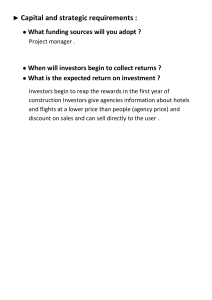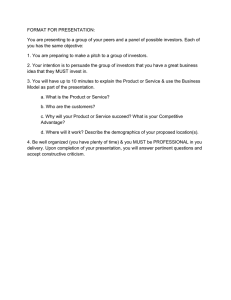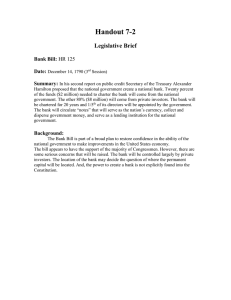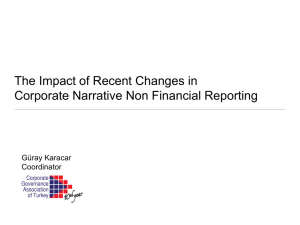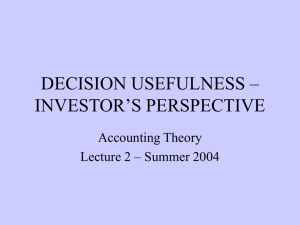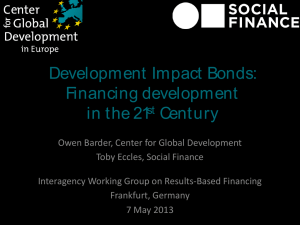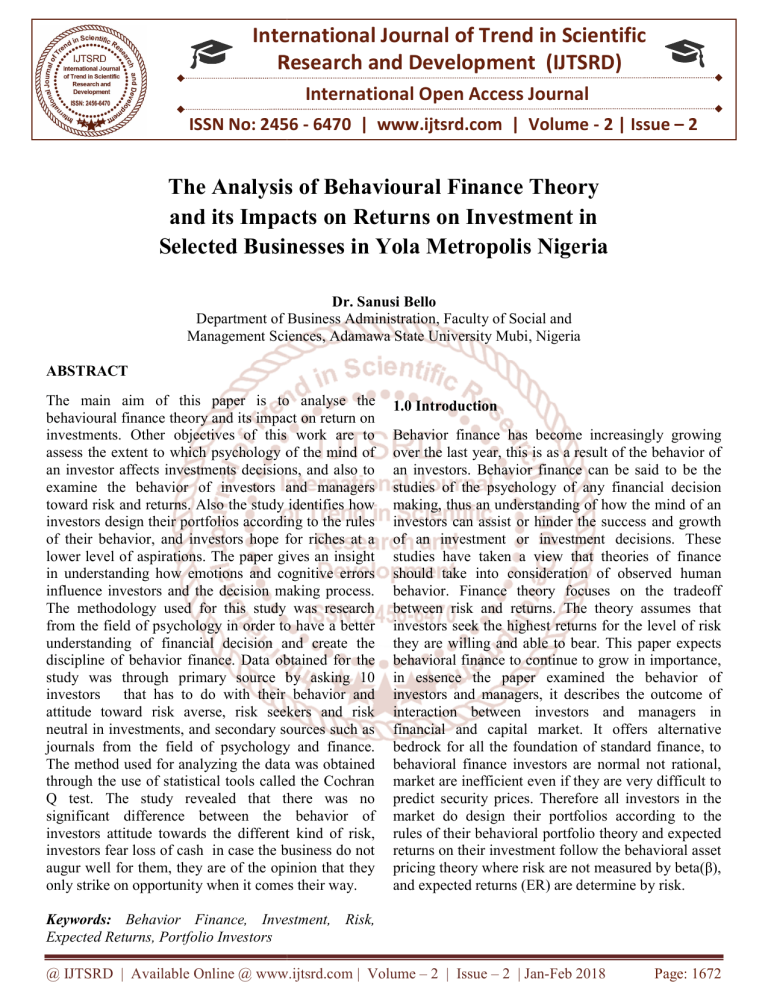
International Journal of Trend in Scientific
Research and Development (IJTSRD)
International Open Access Journal
ISSN No: 2456 - 6470 | www.ijtsrd.com | Volume - 2 | Issue – 2
The Analysis of Behavioural Finance Theory
and its Impacts on Returns on Investment in
Selected Businesses in Yola Metropolis Nigeria
Dr. Sanusi Bello
Department of Business Administration
Administration, Faculty of Social and
Management Sciences
Sciences, Adamawa State University Mubi,, Nigeria
ABSTRACT
The main aim of this paper is to analyse the
behavioural finance theory and its impact on return on
investments. Other objectives of this work are to
assess the extent to which psychology of the mind of
an investor affects investments decisions, and also to
examine the behavior of investors
rs and managers
toward risk and returns. Also the study identifies how
investors design their portfolios according to the rules
of their behavior, and investors hope for riches at a
lower level of aspirations. The paper gives an insight
in understanding how
w emotions and cognitive errors
influence investors and the decision making process.
The methodology used for this study was research
from the field of psychology in order to have a better
understanding of financial decision and create the
discipline of behavior
havior finance. Data obtained for the
study was through primary source by asking 10
investors
that has to do with their behavior and
attitude toward risk averse, risk seekers and risk
neutral in investments, and secondary sources such as
journals from thee field of psychology and finance.
The method used for analyzing the data was obtained
through the use of statistical tools called the Cochran
Q test. The study revealed that there was no
significant difference between the behavior of
investors attitude towards
wards the different kind of risk,
investors fear loss of cash in case the business do not
augur well for them, they are of the opinion that they
only strike on opportunity when it comes their way.
1.0 Introduction
Behavior finance has become increasingly growing
over the last year, this is as a result of the behavior of
an investors. Behavior finance can be said to be the
studies of the psychology of any financial decision
making, thus an understanding of how the mind of an
investors can assist or hinder the success and growth
of an investment or investment decisions. These
studies have taken a view that theories of finance
should take into consideration of observed human
behavior. Finance theory focuses on the tradeoff
between risk and returns. The theory assumes that
investors seek the highest returns for the level of risk
they are willing and able to bear. This paper expects
behavioral
avioral finance to continue to grow in importance,
in essence the paper examined the behavior of
investors and managers, it describes the outcome of
interaction between investors and managers in
financial and capital market. It offers alternative
bedrock for
or all the foundation of standard finance, to
behavioral finance investors are normal not rational,
market are inefficient even if they are very difficult to
predict security prices. Therefore all investors in the
market do design their portfolios according
accordin to the
rules of their behavioral portfolio theory and expected
returns on their investment follow the behavioral asset
pricing theory where risk are not measured by beta(β),
and expected returns (ER) are determine by risk.
Keywords: Behavior Finance, Investment, Risk,
Expected Returns, Portfolio Investors
@ IJTSRD | Available Online @ www.ijtsrd.com | Volume – 2 | Issue – 2 | Jan-Feb
Feb 2018
Page: 1672
International Journal of Trend in Scientific Research and Development (IJTSRD) ISSN: 2456-6470
Objectives of the Study
The main objective of the study is to analyse the
behavioural finance theory and its impacts on return
on investments. The specific objectives of the work
are to:
i. Examine the behavior of investors and managers
toward risk and returns.
ii. Identify how investors design their portfolios
according to the rules of their behavior, and hope
for riches at a lower level of aspirations.
Research Questions
i. In what ways can the behavior of investors and
managers toward risk and returns be assessed?
ii. How can investors design their portfolios
according to the rules of their behavior, and hope
for riches at a lower level of aspirations.
Research Hypotheses
HO 1= There is no any significance difference between
Investors attitude toward risk and return
HO 2= There is no any significance difference between
the behavior of investors biases toward Returns on
Investment (ROI).
2.0 Literature Review
Behavioral finance in this paper is seen as goal based
theory, where all investors divide their wealth into
many mental account layers of a portfolio pyramid
corresponding to goals such as secure retirement,
school fees, or being rich enough to cruise whatever
pleases their minds. Friedman & Savage, (1948)
viewed that hope for riches and protection from
poverty share roles in our behavior, people who buy
lottery tickets often buy insurance policies as well,
therefore people are found to be more risk seeking to
buy lottery tickets while they are risk averse enough
to buy insurance policy.
Friedman & Savage, (1948) further observed that
people who buy lottery tickets because they aspire to
reach high social classes, whereas they buy insurance
as protection against falling into lower social classes.
Markowitz, (1952b) gives clarification of the
Friedman & Savage by noting that people or investor
aspire to move up from their current social class or
customary wealth. Kahneman & Tversky, (1979)
extended the work of Markowitz (1952) into what is
known as prospect theory.
Prospect theory describes the behavior of investors
who accepts lottery – like odds when they are below
their level of aspirations, but rejects such odds when
they are above their level of aspirations. In the other
part of this paper the financial theory based on
modern portfolio theory Markowitz (1952) and that of
Capital Asset Pricing Model (CAPM) Sharp, 1964
paved a way for academicians and investors to
analyse investment to see if it is worthwhile or not.
The theory is based on the fact that investors are
rational and information regarding security price are
readily available to all investors in decision making
process, therefore investment markets are efficient.
Behavioral finance studies the psychology of financial
decision-making. Most people know that emotions
affect investment decisions. People in the industry
commonly talk about the role greed and fear play in
driving stock markets. Behavioral finance extends this
analysis to the role of biases in decision making, such
as the use of simple rules of thumb for making
complex investment decisions Shefrin H, (2000). In
other words, behavioral finance takes the insights of
psychological research and applies them to financial
decision-making. The models within the traditional
finance paradigm assume that investors act rationally
and consider all available information in the decisionmaking process.
Hence, investment markets are efficient and security
prices reflect the true ‘intrinsic values’ of the assets.
That investors act promptly to new information and
update prices correctly within a normatively
acceptable process. Investment market returns are
believed to follow a random walk pattern; hence
considered not predictable. Underlying all these is the
theory if arbitrage, which suggests that rational
investors undo price deviation away from the
fundamental values quickly and maintain market
equilibrium. As such, ‘prices are right’ reflecting all
available information and there is no ‘free lunch’: no
investment strategy can earn excess risk-free rate of
return greater than that warranted by its risk (Fama,
1965). The Modern Portfolio Theory (MPT), Capital
Asset Pricing Model (CAPM) and Arbitrage Pricing
Theory (APT) are the quantitative models that
underpin the rational expectations based theories
(Markowitz, 1995; Sharpe, 1964; Ross, 1976).
Unfortunately, there is a large amount of research
which could not confirm this theory in the available
investment data. For example, Fama and French,
(1993, 1996) and others have shown that the basic
facts about the aggregate stock market, the cross-
@ IJTSRD | Available Online @ www.ijtsrd.com | Volume – 2 | Issue – 2 | Jan-Feb 2018
Page: 1673
International Journal of Trend in Scientific Research and Development (IJTSRD) ISSN: 2456-6470
section average returns and individual trading
behaviour are not easily understood in this
framework. Major property research in this area
includes papers by Miles and McCue (1984), Titman
and Warga (1986), Lusht (1988) and Liu and Mei,
(1992) as such, the behavioural finance paradigm has
emerged in the response to the difficulties faced by
the traditional paradigm. In essence, it argues that
investment choices are not always made on the basis
of full rationality, and it attempts to understand the
investment market phenomena by relaxing the two
doctrines of the traditional paradigm, that is, (1).
Agents fail to update their beliefs correctly and (2).
There is a systematic deviation from the normative
process in making investment choices. The
expectations based models argue that the above
described irrationality will be undone through the
process of arbitrage (Friedman, 1953). Behavioural
finance argues that there is ‘limits to arbitrage’,
which allows investor irrationality to be substantial
and have long-lived impact on prices.
To explain investor irrationality and their decisionmaking process, behavioural finance draws on the
experimental evidence of the cognitive psychology
and the biases that arise when people form beliefs,
preferences and the way in which they make
decisions, given their beliefs and preferences
(Barberis and Thaler, 2003). As such, limit to
arbitrage and psychology are seen as the two building
blocks of behavioural finance.
Arbitrage is an investment strategy that offers riskless profit at no cost. Traditional finance theorists
believe that, any mispricing created by irrational
traders (noise traders) in the marketplace, will create
an attractive opportunity which will be quickly
capitalised on by the rational traders (arbitrageurs)
and the mispricing will be corrected. Behavioural
theorists show that, strategies required to correct the
misprising can both costly and risky; thus, rendering
the mispricing unattractive and allowing them to
continue. Detailed analysis of this argument can be
found in De Long, Shleifer, Summers and Waldmann
(1990) and Shelifer and Vishny (1997).
2.1 Theoretical Literature
2.1.1 Human Behavioural Theories
In order to explain the various irrational investor
behaviours in financial markets, behavioural
economists draw on the knowledge of human
cognitive behavioural theories from psychology,
sociology and anthropology. Major theories used
include:
2.1.2 Prospect Theory
Tversky and Kanheman (1979) by way of developing
the Prospect Theory showed how people manage risk
and uncertainty. In essence, the theory explains the
apparent regularity in human behaviours when
assessing risk under uncertainty.
That is, human beings are not consistently risk-averse;
rather they are risk-averse in gains but risk-takers in
losses. According to Tversky and Kanheman, people
place much more weight on the outcomes that are
perceived more certain than that are considered mere
probable, a feature known as the “certainty effect”.
People’s choice are also affected by ‘framing effect’.
Framing refers to the way a problem is posed to the
decision maker and their ‘mental accounting’ of that
problem. The value maximisation function of the
Prospect Theory is different from that of the value
maximisation function of MPT. Wealth maximisation
is between gains and losses, rather than over the final
wealth position as in MPT (Markowitz, 1952). As
such, people may make different choices in situations
with identical final wealth levels. Critical to the value
maximisation is the reference point from which gains
and losses are measured. Usually, the status quo is
taken as the reference point and changes are measured
against it in relative terms, rather than in absolute
terms.
2.2 Judgement Under Uncertainty
The following theories summarise how people form
beliefs under uncertainty.
2.2.1 Overconfidence: Alpert and Raiffa (1982)
showed that people are poorly calibrated in estimating
probabilities and usually overestimate their precision
of the knowledge and ability to do well. People are
also overconfidence about good things happening in
future than bad. In addition, people overestimate their
confidence to the past positive outcomes and usually
recall only their successes than their failures.
2.2.2 Fear of Regret: Human beings have the
tendency to feel the pain or the fear of regret at having
made errors. As such, to avoid the pain of regret,
people tend to alter their behaviour, which may end
up being irrational at times. Linked with fear of regret
is ‘cognitive dissonance’, which is the mental
@ IJTSRD | Available Online @ www.ijtsrd.com | Volume – 2 | Issue – 2 | Jan-Feb 2018
Page: 1674
International Journal of Trend in Scientific Research and Development (IJTSRD) ISSN: 2456-6470
suffering that people experience when they are
presented with the evidence that their beliefs have
been wrong (Shiller,1995).
Tversky and Kahneman (1974) identified the
influence of human heuristics on the decision- making
process. Tversky at el. defined heuristic as a strategy
that can be applied to a variety of problems and that
usually–but not always–yields a correct solution.
People often use heuristics (or shortcuts) that reduce
complex problem solving to more simple judgmental
operations.
Three of the most popular heuristics discussed by
Tversky at el. include:
2.2.3 Representativeness heuristic: What is the
probability that person A (Steve, a very shy and
withdrawn man) belongs to group B (librarians) or C
(exotic dancers)? In answering such questions, people
typically evaluate the probabilities by the degree to
which A is representative of B or C (Steve´s shyness
seems to be more representative for librarians than for
exotic dancers) and sometimes neglect base rates
(there are far more exotic dancers than librarians in a
certain sample).
2.2.4 Availability heuristic:
This heuristic is used to evaluate the frequency or
likelihood of an event on the basis of how quickly
instances or associations come to mind. When
examples or associations are easily brought to mind,
this fact leads to an overestimation of the frequency or
likelihood of this event. Example: People are
overestimating the divorce rate if they can quickly
find examples of divorced friends.
2.2.5 Anchoring and adjustment:
People who have to make judgments under
uncertainty use this heuristic by starting with a certain
reference point (anchor) and then adjust it
insufficiently to reach a final conclusion. Example: If
you have to judge person´s productivity, the anchor
for your final (adjusted) judgement may be your own
level of productivity. Depending on your own level of
productivity you might therefore underestimate or
overestimate the productivity of this person.
2.2.6 Important Heuristics
Affect: The affect heuristic concerns `goodness' and
`badness'. Affective responses to a stimulus occur
rapidly and automatically, note how quickly you sense
the feelings associated with the stimulus words
treasure or hate.
Availability: Availability is a cognitive heuristic in
which a decision maker relies upon knowledge that is
readily available rather than examine other
alternatives or procedures.
Similarity: The similarity heuristic leads us to believe
that `like causes like' and `appearance equals reality'.
The heuristic is used to account for how people make
judgments based on the similarity between current
situations and other situations or prototypes of those
situations.
2.3 How behavioral biases affect investment
decisions
2.3.1 Overconfidence
Psychology has found that humans tend to have
unwarranted confidence in their decision making. In
essence, this means having an inflated view of one’s
own abilities. This trait appears universal, affecting
most aspects of our lives. Researchers have asked
people to rate their own abilities, for example in
driving, relative to others and found that most people
rate themselves in the top third of the population. Few
people rate their own abilities as below average,
although obviously 50% of all drivers are below
average. Many studies – of company CEOs, doctors,
lawyers, students, and doctors’ patients – have also
found these individuals tend to overrate the accuracy
of their views of the future.
In practical terms, human beings tend to view the
world in positive terms. While this behaviour can be
valuable – it can help you recover from life’s
disappointments more quickly – it can also cause an
ongoing source of bias in money-related decisions.
Barber and Odean (1999), ‘The courage of misguided
convictions.
2.3.2 Overconfidence and investing
Overconfidence has direct applications in investment,
which can be complex and involve forecasts of the
future. Overconfident investors may overestimate
their ability to identify winning investments.
Traditional financial theory suggests holding
diversified portfolios so that risk is not concentrated
in any particular area.
‘Misguided conviction’ can weigh against this advice,
with investors or their advisers ‘sure’ of the good
@ IJTSRD | Available Online @ www.ijtsrd.com | Volume – 2 | Issue – 2 | Jan-Feb 2018
Page: 1675
International Journal of Trend in Scientific Research and Development (IJTSRD) ISSN: 2456-6470
prospects of a given investment, causing them to
believe that diversification is therefore unnecessary.
Overconfidence is linked to the issue of control, with
overconfident investors for example believing they
exercise more control over their investments than they
do. In one study, affluent investors reported that their
own stock-picking skills were critical to portfolio
performance. In reality, they were unduly optimistic
about the performance of the shares they chose, and
underestimated the effect of the overall market on
their portfolio’s performance. In this simple way,
investors overestimate their own abilities and
overlook
broader
factors
influencing
their
investments.
2.3.3 Too much trading
Investors with too much confidence in their trading
skill often trade too much, with a negative effect on
their returns. Professors Brad Barber and Terry Odean
studied U.S investors with retail brokerage accounts
found that more active traders earned the lowest
returns. Whatever insight the traders think they have,
they appear to be overestimating its
value in investment decisions.
2.4 Portfolio turnover and return
2.4.1 Skill and luck
Overconfidence may be fuelled by another
characteristic known as ‘self-attribution bias’. In
essence, this means that individuals faced with a
positive outcome following a decision, will view that
outcome as a reflection of their ability and skill.
However, when faced with a negative outcome, this is
attributed to bad luck or misfortune. This bias gets in
the way of the feedback process by allowing
decisionmakers to block out negative feedback and
the resulting opportunity to improve future decisions.
2.4.2 Loss Aversion
2.5 Attitudes to risk and reward
Established financial theory focuses on the trade-off
between risk and return. Risk from this perspective
means variability of outcomes and riskier investments
should, broadly speaking, offer higher rates of return
as compensation for higher risk. The theory assumes
that investors seek the highest return for the level of
risk they are willing and able to bear. Financial
advisers often ask clients to complete a risk attitude
questionnaire to establish their attitude to risk, and
consider issues such as investment time horizon and
wealth levels to establish risk tolerance. Risk
tolerance drives the types of investments they
recommend for the investor.
2.5.1 Fear of loss
Behavioural finance suggests investors are more
sensitive to loss than to risk and return. Some
estimates suggest people weigh losses more than
twice as heavily as potential gains. For example, most
people require an even (50/50) chance of a gain of
£2,500 in a gamble to offset an even chance of a loss
of £1,000 before they find it attractive.
The idea of loss aversion also includes the findings
that people try to avoid locking in a loss. Consider an
investment bought for £1,000, which rises quickly to
£1,500. The investor would be tempted to sell it in
order to lock-in the profit. In contrast, if the
investment dropped to £500, the investor would tend
to hold it to avoid locking in the loss. The idea of a
loss is so painful that people tend to delay recognising
it. More generally, investors with losing positions
show a strong desire to get back to break even. This
means the investor shows highly risk-averse
behaviour when facing a profit (selling and locking in
the sure gain) and more risk tolerant or risk seeking
behaviour when facing a loss (continuing to hold the
investment and hoping its price rises again).
2.5.2 The disposition effect
Professors Shefrin and Statman developed the idea of
loss aversion into a theory called the ‘disposition
effect’, which indicates that individuals tend to sell
winners and hold losers. In later research, Professors
Barber and Odean tested this idea using data from a
US retail brokerage. They found that investors were
roughly 50% more likely to sell a winning position
than a losing position, despite the fact that US tax
regulations make it beneficial to defer locking in gains
for as long as possible, while crystallising tax losses
as early as possible. They also found that the tendency
to sell winners and hold losers harmed investment
returns.
2.6 The problem of inertia
2.6.1 Regret avoidance
Inertia means that people fail to get around to taking
action, often even on things they want or have agreed
to do. A related issue is a tendency for emotions to
sway you from an agreed course of action – ‘having
second thoughts’. The human desire to avoid regret
drives these behaviours. Inertia can act as a barrier to
effective financial planning, stopping people from
@ IJTSRD | Available Online @ www.ijtsrd.com | Volume – 2 | Issue – 2 | Jan-Feb 2018
Page: 1676
International Journal of Trend in Scientific Research and Development (IJTSRD) ISSN: 2456-6470
saving and making necessary changes to their
portfolios.
A fundamental uncertainty or confusion about how to
proceed lies at the heart of inertia. For example, if an
investor is considering making a change to their
portfolio, but lacks certainty about the merits of
taking action, the investor may decide to choose the
most convenient path – wait and see. In this pattern of
behaviour, so common in many aspects of our daily
lives, the tendency to procrastinate dominates
financial decisions.
2.6.2 Overcoming inertia with an autopilot
In recent years behavioural researchers have designed
‘autopilot’ systems to counteract inertia. For example,
in the realm of retirement planning it has been
observed that many individuals fail to join their
company pension plan, possibly as a result of inertia.
Changing the pension scheme so that employees are
automatically enrolled in the scheme, while retaining
a right to opt out, tends to boost take up rates
considerably. In effect, the automatic enrolment
approach puts inertia to a positive use. Automatic
enrolment is planned for use in the UK’s new pension
regulations, due to be implemented in 2012.
Individuals in pension plans are also often found to be
saving at low rates that are unlikely to generate the
levels of retirement income the individuals would
hope for.
2.7 Autopilot approaches to investing
Autopilot approaches can also have relevance in
investing, such as taking a disciplined approach to
portfolio rebalancing, or a commitment to regular
monthly savings. Such disciplined approaches – often
called ‘commitment devices’ by behavioural
economists – can help investors avoid biases like
overconfidence and promote rational investor
behaviour.
In terms of rebalancing, using a regular schedule for
guiding decisions can help investors to avoid being
swayed by current market conditions, recent
performance of a ‘hot’ investment or other fads. It
results in a regular strategy that sells out of markets or
investments that have recently outperformed and adds
to markets or investments that have lagged. Regular
investing, the process of ‘pound cost averaging, also
helps as the investor tends to accumulate more units
or shares of an investment when markets are low than
when they are high.
2.8 Constructing Portfolios
2.8.1 Framing
Finance theory recommends we treat all of our
investments as a single pool, or portfolio, and
consider how the risks of each investment offset the
risks of others within the portfolio. We’re supposed to
think comprehensively about our wealth. Rather than
focusing on individual securities or simply our
financial assets, traditional financial theory believes
that we consider our wealth comprehensively,
including our house, company pensions, government
benefits and our ability to produce income.
However,
human
beings
tend
to
focus
overwhelmingly on the behaviour of individual
investments or securities. As a result, in reviewing
portfolios investors tend to fret over the poor
performance of a specific asset class or security or
mutual fund. These ‘narrow’ frames tend to increase
investor sensitivity to loss. By contrast, by evaluating
investments and performance at the aggregate level,
with a ‘wide’ frame, investors tend to exhibit a greater
tendency to accept short-term losses and their effects.
2.8.2 Mental accounting
Our psychological self thinks about money and risk
through ‘mental accounts’ – separating our wealth
into various buckets or pools. We often base these
pools on goals or time horizon (such as ‘retirement’ or
‘school fees’). Accounts can also vary in risk
tolerance, investing some in risky assets for gain
while treating others more conservatively.
Investors pay less attention to the relationship
between the investments held in the different mental
accounts than traditional theory suggests. This natural
tendency to create mental buckets also causes us to
focus on the individual buckets rather than thinking
broadly, in terms of our entire wealth position.
2.9 Behavioural portfolio theory
In some early versions of portfolio theory, economists
suggested that most investors seek to balance security
with the small chance for big winnings. Thus portfolio
allocations should be based on a combination of
‘insurance’ (protection against losses) and ‘lotteries’
(small odds of a large gain). Behavioural economists
Shefrin and Statman formalised this approach in their
behavioural portfolio theory based on mental
accounts. They view behavioural portfolios as being
formed of a layered pyramid, with each layer a
separate mental account. The base layers represent
assets designed to provide ‘protection from poverty’,
which results in conservative investments designed to
@ IJTSRD | Available Online @ www.ijtsrd.com | Volume – 2 | Issue – 2 | Jan-Feb 2018
Page: 1677
International Journal of Trend in Scientific Research and Development (IJTSRD) ISSN: 2456-6470
avoid loss. Higher layers represent ‘hopes for riches’
and are invested in risky assets in the hope of high
returns. This idea explains why an individual investor
can simultaneously display risk-averse and risktolerant behaviour, depending on which mental
account they’re thinking about. This model can help
explain why individuals can buy at the same time both
‘insurance’ such as gilts and ‘lottery tickets’ such as a
handful of small-cap stocks. The theory also suggests
that investors treat each layer in isolation and don’t
consider the relationship between the layers.
Established finance theory holds that the relationship
between the different assets in the overall portfolio is
one of the key factors in achieving diversification.
has to do with their behavior and attitude toward risk
averse, risk seekers and risk neutral in investments,
and secondary sources such as journals from the field
of psychology and finance. The method used for
analyzing the data obtained is through the use of
statistical tools called the Cochran Q test. It is a tools
that is meant to evaluate data of nominal scale or
characteristics. These scale can be in form of Yes or
No, Effective or Ineffective, Good or Bad, Likes or
Dislikes, etc.for the purpose of these study the weight
attached to these scale are Yes = 1 and No = 0.
The Cochran Q test is given by:
Q = (K-1)[K(Ƹs21 + ƸS22 + ………….+ ƸS2K] – ƸL2] /
K(ƸL) – ƸL2
3.0 Methodology
The methodology used for this study was research
from the field of psychology in order to have a better
understanding of financial decision and create the
discipline of behavior finance. Data obtained for the
study was through primary source by asking 10
investor in different kind of businesses, questions that
Where K = Number of samples
ƸSK = sum of favourable responses to each samples
ƸL = sum of favourable responses from all
respondents in all the samples
1 = assigned to Yes
0 = assigned to No
4.0 Result and Discussions
4.1 Hypothesis 1: To test whether there is a difference in the behavior of investor and attitude towards risk.
Respondent
Risk Averse
(Investors)
Chemist
1
Phone cards
0
Restaurants
0
Confectionaries 1
Photo Studio
1
VideoCoverage 0
BusinessCentres 1
Tailoring
0
Transportation
1
Cosmetics
1
Total
6
(Total)2
36
Source: Field Work, 2015
Risk Neutral
Risk Seekers
SV
SV2
1
1
0
0
1
0
1
1
0
0
5
25
0
0
1
0
0
1
0
0
1
1
4
16
2
1
1
1
2
1
2
1
2
2
15
77
4
1
1
1
4
1
4
1
4
4
25
Using Cochran Q test
Q = (K-1)[K(Ƹs21 + ƸS22 + ………….+ ƸS2K] – ƸL2] / K(ƸL) – ƸL2
Q = 3-1[3(36+25+16] – 225] / 3(15)-25
Q = 2[3(77- 225)] / 20
Q = 2[231-225] / 20
Q = 2(6) / 20
Q = 12/20
Q = 0.60
@ IJTSRD | Available Online @ www.ijtsrd.com | Volume – 2 | Issue – 2 | Jan-Feb 2018
Page: 1678
International Journal of Trend in Scientific Research and Development (IJTSRD) ISSN: 2456-6470
The critical value of Q at 0.05 level of significance at (3-1) degree of freedom is 5.99 from the X 2 table. Since
the calculated value of Q = 0.60 is less than the critical value of 5.99, we cannot reject the null hypothesis. It is
therefore conclude that there is no significance difference in the behavior of Investors attitude towards risk.
4.2 Hypothesis 2: To test whether there is a difference between the behavior of investors/managers biases and
Return on Investment.
Respondent
Overconfidence Toomuch
Inertia
SV
SV2
(Investors)
trading
problems
Risk neutral
1
1
0
2
4
Risk
0
1
0
1
1
avoidance
Risk seekers
0
0
1
1
1
Total
1
2
1
4
6
(Total)2
1
4
1
6
Source: Field Work, 2015
Using Cochran Q test
Q = (K-1)[K(Ƹs21 + ƸS22 + ………….+ ƸS2K] – ƸL2] / K(ƸL) – ƸL2
Q = 3-1[3(1+4+1] – 16] / 3(4)-6
Q = 2[3(6- 16)] / 6
Q = 2[-30] / 6)
Q = -60 / 20
Q = -3
The critical value of Q at 0.05 level of significance at (3-1) degree of freedom is 5.99 from the X 2 table. Since
the calculated value of Q = -3.0 is less than the critical value of 5.99, we cannot reject the null hypothesis. It is
therefore conclude that there is no significance difference in the behavior of Investors/managers biases towards
return on investment risk.
5.0 Conclusion
References
This paper the analysis of behaviuoral finance theory
and its impacts on returns on investment in some
selected businesses in Yola Metropolis. Behavior
finance is expected to continue to grow in importance,
the paper examines the behavior of investors and
managers, it describe the outcome of interaction
between investor sand managers in financial and
capital market. Therefore all investor in the market do
design their portfolios according to the rules of their
behavior portfolio theory and expected returns. The
paper is also seen as a goal based theory where all
investors divide their wealth into many mental
account layers of portfolio pyramid corresponding to
goal such as school fees, secure retirement, or being
rich enough to cruise whatever pleases their minds
Friedman & Savage (1948) opined that hope for
riches and protection from poverty share roles in our
behavior, people who buys lottery tickets often buys
insurance policies as well, therefore, people are found
to be more risk seeking to buy lottery tickets while
they are risk averse enough to buy insurance policy.
1. Fama, e.f. 1991. “efficient capital markets.”
Journal of finance, vol. 46, no. (december):15751617
2. Fama, e.f. 1965. “random walks in stock market
prices.” Financial analysts journal, vol. 21, no. 5
(september/october):55–59.
Doi:10.2469/faj.v21.n5.55
3. Fama, e.f., and k. French. 1992. “the cross-section
of expected stock returns.” Journal of finance,
vol. 47, no. 2 (june):427–465.
4. Fair, r. 2002. “the events that shook the market.”
Journal of business, vol. 75, no. 4 (october):713–
731. Doi:10.1086/341640
5. Friedman, m., and l. Savage. 1948. “the utility
analysis of choices involving risk.” Journal of
political economy, vol. 56, no. 4 (august):279–
304.
6. Kahneman, d., and a. Tversky. 1979. “prospect
theory: an analysis of decision under risk.”
Econometrica, vol. 47, no. 2 (march):263–291.
@ IJTSRD | Available Online @ www.ijtsrd.com | Volume – 2 | Issue – 2 | Jan-Feb 2018
Page: 1679
International Journal of Trend in Scientific Research and Development (IJTSRD) ISSN: 2456-6470
7. Mangalindan, m. 2002. “hoping is hard in silicon
valley.” Wall street journal (july 15): cl.
8. Markowitz, h.m. 1952a. “portfolio selection.”
Journal of finance, vol. 7, no. 1 (march):77–91.
9. Markowitz, h.m 1952b. “the utility of wealth.”
Journal of political economy, vol. 60, no. 2
(april):151–158.
10. Markowitz, h.m. 1959. Portfolio selection:
diversification of investments. New york: john
wiley
& sons.
11. Markowitz, h.m. 1999. “the early history of
portfolio theory: 1600–1960.” Financial analysts
journal, vol. 55, no. 4 (july/august):5–15.
12. Miller, M.H. 1986. “Behavioral Rationality in
finance: the case of dividends.” Journal of
business,
vol. 59, no. 4 (october):s451–s468.
13. Miller, M., and F. Modigliani. 1961. “dividend
policy, growth, and the valuation of shares.”
Journal of business, vol. 34, no. 4 (october):411–
433.
14. Pontiff, J. 2006. “costly arbitrage and the myth of
idiosyncratic risk.” Journal of accounting and
economics, vol. 42, no. 1–2 (october):35–52.
16. Shefrin, H.M., and M. Statman. 1984. “explaining
investor preference for cash dividends.” Journal of
financial economics, vol. 13, no. 2 (june):253–
282.
17. Shefrin, H.M., and M. Statman. 1985. “the
disposition to sell winners too early and ride losers
too long: theory and evidence.” Journal of finance,
vol. 40, no. 3 (july):777–790.
18. Shefrin, H.M., and M. Statman. 1994. “behavioral
capital asset pricing theory.” Journal of financial
and quantitative analysis, vol. 29, no. 3
(september):323–349.
19. Shefrin, H.M., and mM. Statman. 2000.
“behavioral portfolio theory.” Journal of financial
and
quantitative analysis, vol. 35, no. 2
(june):127–151.
20. Snyder, WH..T. 1957. “how to take a loss and like
it.” Financial analysts journal, vol. 13, no. 2
(may):115–116. Doi:10.2469/faj.v13.n2.115
21. Statman, M. 2005. “Martha Stewart’s lessons in
behavioral finance.” Journal of investment
consulting, vol. 7, no. 2 (winter):52–60.
15. Sharpe, W.F. 1964. “capital asset prices: a theory
of market equilibrium under conditions of risk.”
Journal of finance, vol. 19, no. 3 (september):425–
442.
@ IJTSRD | Available Online @ www.ijtsrd.com | Volume – 2 | Issue – 2 | Jan-Feb 2018
Page: 1680

